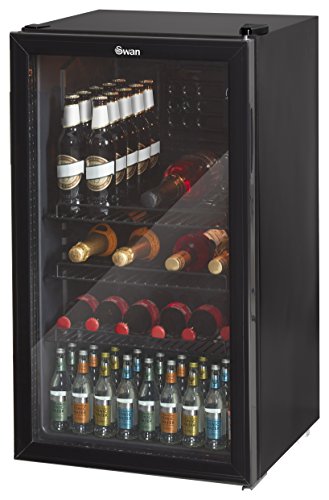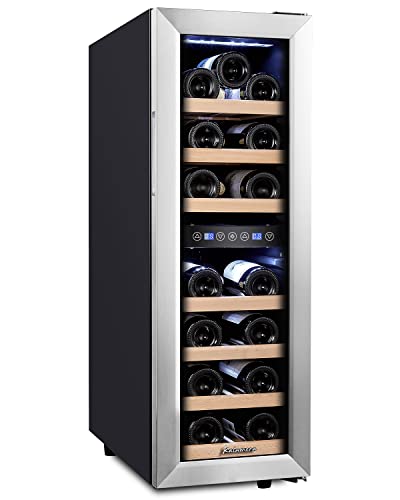Guide To Wine Cooler And Fridge: The Intermediate Guide The Steps To W…
페이지 정보

본문
 How a Wine Cooler and Fridge Can Help Preserve Your Cabernet Sauvignon and White Zinfandel
How a Wine Cooler and Fridge Can Help Preserve Your Cabernet Sauvignon and White ZinfandelKeep your Cabernet Sauvignon and White Zinfandel at the ideal serving temperature with wine refrigerators. Some wine refrigerators, like the KitchenAid Undercounter electric wine chiller Cellar (R) control the interior humidity to protect labels and wines against mould.
Traditional refrigerators have plenty of dangers that can degrade the rich flavor of your wine. This is the reason designated wine fridges are in place.
The Ideal Temperature
A wine cooler fridge fridge is an excellent way to keep your collection of wines at the ideal serving temperature. This makes it easy to serve them. The temperature of the wine should be maintained at a consistent and stable temperature to preserve the flavor and aroma of the wine while slowing down the process of aging. The temperature should be a little cooler than ambient temperature to ensure that the wine doesn't get too cold, which can diminish the flavors.
The top wine coolers are made to keep the temperature between 54 and 57 degrees Fahrenheit (11 and 14 Celsius). This is the ideal temperature range for long-term storage, as it will slow the process of aging and prevent the wine from becoming dry. However it is important that the temperature not be too low because this could cause oxidation and other problems.
You can utilize a single-zone wine refrigerator to keep all your wine collection or purchase a dual-zone wine refrigerator that allows you to separate the wine into two distinct zones to better control the temperature. You can keep red wines in one zone and whites in a different, so you can serve each wine at the ideal temperature. This will enhance your drinking experience and make it easy to prepare for an event like a cocktail party or dinner. You can simply shift the bottles in the right zone the night prior.
Some models of wine refrigerators will have a user manual that contains specific information about temperature settings. It is essential to read this document carefully to get familiar with the particular temperature control features of your wine cooler. It is also a great idea to monitor the temperature of your wine fridge regularly, as it can fluctuate. It is recommended to keep the wine refrigerator in a location far from sunlight and heat sources, as this will help to keep the interior of the fridge from becoming too hot. In addition, it is best to not open the wine fridge, since this could cause the internal temperature to fluctuate.
Humidity Control
Humidity is a key element in the storage of wine. Low humidity levels cause corks to dry out, weakening the seal and allowing oxygen in to enter the bottle. This can alter the taste of the wine, and lead to off-flavors. High humidity can encourage the development of mildew and mold which can impact the labels on wine bottles. A wine cooler that has integrated humidity control will help you to achieve optimal conditions for aging your wine collection.
The ideal range of humidity is between 50% and 50% to. Some wine refrigerators come with a dehumidifying feature that helps regulate humidity by removing excess moisture. This is important as high levels of humidity could cause damage to the quality and legibility of wine labels. A consistent humidity level also encourages even maturation and more complex flavors as time passes.
Humidification techniques for your wine fridge are easy and simple to implement. The most popular method is to place a small tray filled with water in the base of your refrigerator. As time passes, the water will evaporate, increasing the humidity in your wine refrigerator. You can also opt for a humidifier specially designed for small spaces. Some are energy efficient and feature a a humidity setting that can be adjustable.
Another alternative is to use baking soda, which has natural properties to absorb moisture. You can open a container and put it in a strategic location inside your refrigerator to reduce excessive moisture. In the same way, you can utilize silica gel packets that are commonly used in packaging of products like electronics and food to absorb moisture. Make certain to replace them regularly.
Certain wine fridges come with built-in humidity control systems that automatically regulate moisture levels based on preset parameters. These systems are more precise than passive methods, and can be especially useful if you own an extensive wine storage area that has different requirements for humidity levels for various types of wine. Additionally, professional custom wine cellars come with built-in cooling systems that provide a controlled environment for aging your wine collection. They are generally best suited for premium wines that require a stable environment to age.
Noise Reduction
Wine coolers and fridges are great investments for those who wish to keep the quality of their wine. They can create noise that can be distracting or disruptive. There are fortunately several options to reduce the level of noise generated by these units.
Compressor cycling is a significant source of noise in wine refrigerators. This process involves the circulation of refrigerant to cool the refrigerator's interior and can result in groaning and buzzing noises. It is therefore important to put the fridge on a flat, stable surface in order to minimize noise and vibrations.
Internal Vibrations
Another source of wine fridge noise is the sound of scraping or rattling that is caused by bottles rubbing against one another and the shelves. To reduce this noise make sure the bottles are tightly packed and stored securely to reduce movement. To minimize the noise, it's helpful to make use of wooden racks or shelves instead of metal.
The amount of noise that is emitted from a wine fridge can be reduced by ensuring the proper airflow. It is also essential to clean the fridge on a regular basis to get rid of dust and other debris that can accumulate and impede the flow of air. Finally, it is recommended to put an isolation pad made of rubber under the fridge in order to isolate it from the floor and reduce any vibrations that can cause noise.
Typically, wine refrigerators produce 35 to 45 decibels in their normal operation. This is similar to the background sounds heard in a quiet suburban residence or library. It is an appliance that has a low noise level.
If you're experiencing a wine fridge that is making louder than normal noises, it's beneficial to refer to the manufacturer's troubleshooting guide or contact a technician for a repair visit. This will let you know if the appliance is working properly or if there's a more serious issue at hand. The technician can diagnose the problem and fix it if needed.
Versatility
While fridges are excellent for keeping beverages cool however, if you're looking for a place to preserve and mature your wine, a regular refrigerator will not provide the ideal setting to do so. A wine cooler keeps your bottles at the optimal temperature and also shield them from harmful vibrations. It also maintains a high humidity level for optimum storage.
The typical fridge is opened multiple times a day, which allows moisture to enter the fridge, causing the temperature to fluctuate. This can harm your wine chiller uk as it takes some time for the temperature to return to its optimal storage level. A wine fridge is a different matter. It typically has a lock as well as fewer openings reducing temperatures and air exposure. In addition, wine and beverage fridge refrigerators usually include a vibration absorption device which helps to ensure that your wine is not damaged caused by the compressor vibration.
Besides the dangers of temperature fluctuations, a wine refrigerator can also stop unpleasant smells from entering the wine bottle because of odors from other foods stored in the refrigerator. This could affect the flavor of your wine, and create a strong odor on the cork that can be absorbed into your wine.
 A wine fridge will be able to store both red and white wine and have shelves that can hold bottles upright, allowing you to showcase their gorgeous artwork on the label. Some wine fridges offer dual zone settings to enable you to store, chill and age wines at their own unique temperatures. Whether you're an avid collector or simply enjoy sharing wine to your friends, wine fridges are essential for any home. They are available in a variety of sizes and styles, including freestanding wine fridge units and built-in models. Find the perfect wine fridge.
A wine fridge will be able to store both red and white wine and have shelves that can hold bottles upright, allowing you to showcase their gorgeous artwork on the label. Some wine fridges offer dual zone settings to enable you to store, chill and age wines at their own unique temperatures. Whether you're an avid collector or simply enjoy sharing wine to your friends, wine fridges are essential for any home. They are available in a variety of sizes and styles, including freestanding wine fridge units and built-in models. Find the perfect wine fridge.- 이전글Is Your Company Responsible For A Small Business SEO Services Budget? 12 Best Ways To Spend Your Money 24.11.23
- 다음글The No. Question That Everyone In Citroen Key Replacement Near Me Needs To Know How To Answer 24.11.23
댓글목록
등록된 댓글이 없습니다.














